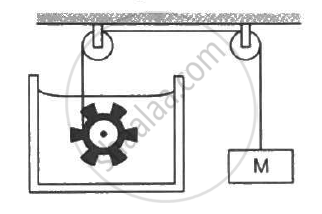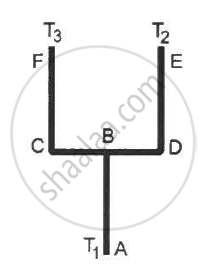Advertisements
Advertisements
प्रश्न
Following figure shows two adiabatic vessels, each containing a mass m of water at different temperatures. The ends of a metal rod of length L, area of cross section A and thermal conductivity K, are inserted in the water as shown in the figure. Find the time taken for the difference between the temperatures in the vessels to become half of the original value. The specific heat capacity of water is s. Neglect the heat capacity of the rod and the container and any loss of heat to the atmosphere.

उत्तर
Rate of transfer of heat from the rod is given as
`(DeltaQ)/(Deltat) = (KA(T_1 - T_2))/l`
In time t, the temperature difference becomes half.
In time Δt, the heat transfer from the rod will be given by
`DeltaQ = (KA(T_1 - T_2))/l Deltat`............(i)
Heat loss by water at temperature T1 is equal to the heat gain by water at temperatureT2.
Therefore, heat loss by water at temperature T1 in time `Deltat` is given by
`DeltaQ=ms(T_1 - T_1) ............(ii)`
From equation (i) and (ii),
ms `( T_1 - T_1' ) = (KA(T_1 - T_2))/l Delta t`
`⇒ T_1' = T_1 - (KA(T_1 - T_2))/(l(ms) Delta t`
This gives us the fall in the temperature of water at temperature T1.
Similarly, rise in temperature of water at temperature T2 is given by
`T_2'= T_2 +( KA(T_1 - T_2))/(l(ms) )Delta t`
Change in the temperature is given by
`(T_1' - T_2' ) = ( T_1 - T_2)- 2 (KA(T_1 - T_2))/(l(ms)) Deltat`
`⇒ (T_1 - T_2) - ( T_1' - T_2') = 2 (KA(T_1 - T_2))/(l(ms)) Deltat`
`⇒ (DeltaT)/(Deltat) = 2 (KA(T_1 - T_2))/(l(ms)`
Here, `(DeltaT)/(Deltat)` is the rate of change of temperature difference.
Taking limit Δ t→ 0,
`⇒ (dT)/dt = 2 (KA (T_1 - T_2))/ (l(ms))`
`rArr (dT)/(T_1 - T_2 )= 2(KA)/(l(ms)dt`
On integrating within proper limit, we get
\[\int_{(T_1 - T_2)}^{(T_1 - T_2)/2}\] `(dT)/((T_1 - T_2)) = 2 (KA)/(l(ms))` \[\int\limits_0^t dt\]
`⇒ In [((T_1- T_2))/(2(T_1 - t_2)]] = 2 = (KA)/(l(ms))t `
`⇒In [ 2] = 2(KA)/(l(ms))t`
`⇒ t = In [2] (lms)/(2KA)`
APPEARS IN
संबंधित प्रश्न
Explain why a brass tumbler feels much colder than a wooden tray on a chilly day
Two identical rectangular strips, one of copper and the other of steel, are riveted together to form a bimetallic strip (acopper> asteel). On heating, this strip will
Find the ratio of the lengths of an iron rod and an aluminium rod for which the difference in the lengths is independent of temperature. Coefficients of linear expansion of iron and aluminium are 12 × 10–6 °C–1 and 23 × 10–6 °C–1 respectively.
One end of a steel rod (K = 46 J s−1 m−1°C−1) of length 1.0 m is kept in ice at 0°C and the other end is kept in boiling water at 100°C. The area of cross section of the rod is 0.04 cm2. Assuming no heat loss to the atmosphere, find the mass of the ice melting per second. Latent heat of fusion of ice = 3.36 × 105 J kg−1.
A steel frame (K = 45 W m−1°C−1) of total length 60 cm and cross sectional area 0.20 cm2, forms three sides of a square. The free ends are maintained at 20°C and 40°C. Find the rate of heat flow through a cross section of the frame.
A cubical box of volume 216 cm3 is made up of 0.1 cm thick wood. The inside is heated electrically by a 100 W heater. It is found that the temperature difference between the inside and the outside surface is 5°C in steady state. Assuming that the entire electrical energy spent appears as heat, find the thermal conductivity of the material of the box.
Following Figure shows water in a container having 2.0 mm thick walls made of a material of thermal conductivity 0.50 W m−1°C−1. The container is kept in a melting-ice bath at 0°C. The total surface area in contact with water is 0.05 m2. A wheel is clamped inside the water and is coupled to a block of mass M as shown in the figure. As the block goes down, the wheel rotates. It is found that after some time a steady state is reached in which the block goes down with a constant speed of 10 cm s−1 and the temperature of the water remains constant at 1.0°C. Find the mass M of the block. Assume that the heat flows out of the water only through the walls in contact. Take g = 10 m s−2.

On a winter day when the atmospheric temperature drops to −10°C, ice forms on the surface of a lake. (a) Calculate the rate of increase of thickness of the ice when 10 cm of the ice is already formed. (b) Calculate the total time taken in forming 10 cm of ice. Assume that the temperature of the entire water reaches 0°C before the ice starts forming. Density of water = 1000 kg m−3, latent heat of fusion of ice = 3.36 × 105 J kg−1and thermal conductivity of ice = 1.7 W m−1°C−1. Neglect the expansion of water of freezing.
A semicircular rod is joined at its end to a straight rod of the same material and the same cross-sectional area. The straight rod forms a diameter of the other rod. The junctions are maintained at different temperatures. Find the ratio of the heat transferred through a cross section of the semicircular rod to the heat transferred through a cross section of the straight rod in a given time.
Consider the situation shown in the figure . The frame is made of the same material and has a uniform cross-sectional area everywhere. Calculate the amount of heat flowing per second through a cross section of the bent part if the total heat taken out per second from the end at 100°C is 130 J.

Four identical rods AB, CD, CF and DE are joined as shown in following figure . The length, cross-sectional area and thermal conductivity of each rod are l, A and K respectively. The ends A, E and F are maintained at temperature T1, T2 and T3 respectively. Assuming no loss of heat to the atmosphere, find the temperature at B.

There are two identical vessels filled with equal amounts of ice. The vessels are of different metals. If the ice melts in the two vessels in 20 and 35 minutes respectively, the ratio of the coefficients of thermal conductivity of the two metals is:
The coefficient of thermal conductivity depends upon ______.
These days people use steel utensils with copper bottom. This is supposed to be good for uniform heating of food. Explain this effect using the fact that copper is the better conductor.
A thin rod having length L0 at 0°C and coefficient of linear expansion α has its two ends maintained at temperatures θ1 and θ2, respectively. Find its new length.
According to Stefan’s law of radiation, a black body radiates energy σT4 from its unit surface area every second where T is the surface temperature of the black body and σ = 5.67 × 10–8 W/m2K4 is known as Stefan’s constant. A nuclear weapon may be thought of as a ball of radius 0.5 m. When detonated, it reaches temperature of 106 K and can be treated as a black body.
- Estimate the power it radiates.
- If surrounding has water at 30°C, how much water can 10% of the energy produced evaporate in 1s? [Sw = 4186.0 J/kg K and Lv = 22.6 × 105 J/kg]
- If all this energy U is in the form of radiation, corresponding momentum is p = U/c. How much momentum per unit time does it impart on unit area at a distance of 1 km?
As per the given figure, two plates A and B of thermal conductivity K and 2 K are joined together to form a compound plate. The thickness of plates are 4.0 cm and 2.5 cm respectively and the area of cross-section is 120 cm2 for each plate. The equivalent thermal conductivity of the compound plate is `(1+5/alpha)`K, then the value of a will be ______.

